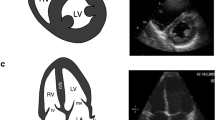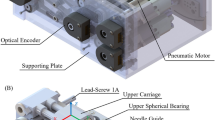Abstract
Purpose
Real-time MRI-guided laser interstitial thermal therapy (LITT) is a challenging procedure due to its technical complexity, as well as the need for efficient multidisciplinary teamwork and transfer of an anesthetized patient between operating room (OR) and magnetic resonance (MR). A highly realistic simulation was developed to design the safest process before being applied to real patients. In this report, authors address the description of the methodology used for this simulation and its purposefulness.
Methods
The entire image planning, anesthetic, and surgical process were performed on a modified pediatric simulation mannequin with a brain made of medical grade silicone including a hypothalamic hamartoma. Preoperative CT and MR were acquired. Stereotactic insertion of the optical fiber was assisted by the Neuromate® stereotactic robot. Laser ablation was performed with the Medtronic Visualase® MRI-guided system in a 3T Phillips Ingenia® MR scanner. All the stages of the process, participants, and equipment were the same as planned for a real surgery.
Results
No critical errors were found in the process design that prevented the procedure from being performed with adequate safety. Specific proposals for team positioning and interaction in patient transfers and in MR room were validated. Some specific elements that could improve safety were identified.
Conclusion
Highly realistic simulation has been an extremely useful tool for safely planning LITT, because professionals were able to take actions in the workflow based not on ideas but on lived experiences. It contributed definitively to build a well-coordinated surgical team that worked safely and more efficiently.






Similar content being viewed by others
References
Ball T, Sharma M, White AC, Neimat JS (2018) Anterior corpus callosotomy using laser interstitial thermal therapy for refractory epilepsy. Stereotact Funct Neurosurg 96(6):406–411. https://doi.org/10.1159/000495414
Bernardo A (2017) Virtual reality and simulation in neurosurgical training. World Neurosurg 106:1015–1029. https://doi.org/10.1016/j.wneu.2017.06.140
Bova FJ, Rajon DA, Friedman WA, Murad GJ, Hoh DJ, Jacob RP, Lampotang S, Lizdas DE, Lombard G, Lister JR (2013) Mixed-reality simulation for neurosurgical procedures. Neurosurgery 73(Suppl 1):138–145. https://doi.org/10.1227/NEU.0000000000000113
Buckley RT, Wang AC, Miller JW, Novotny EJ, Ojemann JG (2016) Stereotactic laser ablation for hypothalamic and deep intraventricular lesions. Neurosurg Focus 41(4):E10. https://doi.org/10.3171/2016.7.FOCUS16236
Burrows AM, Marsh WR, Worrell G, Woodrum DA, Pollock BE, Gorny KR, Felmlee JP, Watson RE, Kaufmann TJ, Goerss S, Van Gompel JJ (2016) Magnetic resonance imaging-guided laser interstitial thermal therapy for previously treated hypothalamic hamartomas. Neurosurg Focus 41(4):E8. https://doi.org/10.3171/2016.7.FOCUS16218
Candela S, Vanegas MI, Darling A, Ortigoza-Escobar JD, Alamar M, Muchart J, Climent A, Ferrer E, Rumià J, Pérez-Dueñas B (2018) Frameless robot-assisted pallidal deep brain stimulation surgery in pediatric patients with movement disorders: precision and short-term clinical results. J Neurosurg Pediatr 22:416–425. https://doi.org/10.3171/2018.5.PEDS1814
Candela-Cantó S, Aparicio J, López JM, Baños-Carrasco P, Ramírez-Camacho A, Climent A, Alamar M, Jou C, Rumià J, San Antonio-Arce V, Arzimanoglou A, Ferrer E (2018) Frameless robot-assisted stereoelectroencephalography for refractory epilepsy in paediatric patients: accuracy, usefulness and technical issues. Acta Neurochir 160(12):2489–2500. https://doi.org/10.1007/s00701-018-3720-8
Chan S, Conti F, Salisbury K, Blevins NH (2013) Virtual reality simulation in neurosurgery: technologies and evolution. Neurosurgery 72(Suppl 1):154–164. https://doi.org/10.1227/NEU.0b013e3182750d26
Cohen AR, Lohani S, Manjila S, Natsupakpong S, Brown N, Cavusoglu MC (2013) Virtual reality simulation: basic concepts and use in endoscopic neurosurgery training. Childs Nerv Syst 29(8):1235–1244. https://doi.org/10.1007/s00381-013-2139-z
Curry DJ, Gowda A, McNichols RJ, Wilfong AA (2012) MR-guided stereotactic laser ablation of epileptogenic foci in children. Epilepsy Behav 24:408–414. https://doi.org/10.1016/j.yebeh.2012.04.135
Curry DJ, Raskin J, Ali L, Wilfong AA (2018) MR-guided laser ablation for the treatment of hypothalamic hamartomas. Epilepsy Res 142:131–134. https://doi.org/10.1016/j.eplepsyres.2018.03.013
Delorme S, Laroche D, DiRaddo R, Del Maestro RF (2012) NeuroTouch: a physics-based virtual simulator for cranial microneurosurgery training. Neurosurgery (Suppl Operative):32–42. https://doi.org/10.1227/NEU.0b013e318249c744
Denson JS, Abrahamson S (1969) A computer-controlled patient simulator. JAMA 208(3):504–508. https://doi.org/10.1001/jama.1969.03160030078009
Deutsch ES (2017) Bridging the gap between work-as-imagined and work-as-done. Pennsylvania Patient Safety Advisory 14(2):80–83 http://patientsafety.pa.gov/ADVISORIES/Pages/201706_80.aspx
Du VX, Gandhi SV, Rekate HL, Mehta AD (2017) Laser interstitial thermal therapy: a first line treatment for seizures due to hypothalamic hamartoma? Epilepsia 58(Suppl 2):77–84. https://doi.org/10.1111/epi.13751
Ferroli P, Tringali G, Acerbi F, Schiariti M, Broggi M, Aquino D, Broggi G (2013) Advanced 3-dimensional planning in neurosurgery. Neurosurgery 72(Suppl 1):54–62. https://doi.org/10.1227/NEU.0b013e3182748ee8
González J, Enseñat J, Candela-Cantó S, Rumià J, Caral LA, Oliver D, Ferrer E (2009) New stereoscopic virtual reality system application to cranial nerve microvascular decompression. Acta Neurochir 152(2):355–360. https://doi.org/10.1007/s00701-009-0569-x
González-Martínez J, Vadera S, Mullin J, Enatsu R, Alexopoulos AV, Patwardhan R, Bingaman W, Najm I (2014) Robot-assisted stereotactic laser ablation in medically intractable epilepsy: operative technique. Operative Neurosurgery 10:167–173. https://doi.org/10.1227/NEU.0000000000000286
Hale AT, Sen S, Haider AS, Perkins FF, Clarke DF, Lee MR, Tomycz LD (2019) Open resection versus laser interstitial thermal therapy for the treatment of pediatric insular epilepsy. Neurosurgery 85(4):E730–E736. https://doi.org/10.1093/neuros/nyz094
Hawasli AH, Bandt SK, Hogan RE, Werner N, Leuthardt EC (2014) Laser ablation as treatment strategy for medically refractory dominant insular epilepsy: therapeutic and functional considerations. Stereotact Funt Neurosurg 92:397–404. https://doi.org/10.1159/000366001
Ho AL, Miller KJ, Cartmel S, Inoyama K, Fisher RS, Halpern CH (2016) Stereotactic laser ablation of the splenium for intractable epilepsy. Epilepsy Behav Case Rep 5:23–26. https://doi.org/10.1016/j.ebcr.2015.12.003
Hoppe C, Helmstaedter C (2018) Laser interstitial thermotherapy (LiTT) in pediatric epilepsy surgery. Seizure. https://doi.org/10.1016/j.seizure.2018.12.010
Huang Y, Yecies D, Bruckert L, Parker JJ, Ho AL, Kim LH, Fornoff L, Wintermark M, Porter B, Yeom KW, Halpern CH, Grant GA (2019) Stereotactic laser ablation for completion corpus callosotomy. J Neurosurg Pediatr 2:1–9. https://doi.org/10.3171/2019.5.PEDS19117
Kang JY, Wu C, Tracy J, Lorenzo M, Evans J, Nei M, Skidmore C, Mintzer S, Sharan AD, Sperling MR (2016) Laser interstitial thermal therapy for medically intractable mesial temporal lobe epilepsy. Epilepsia 57:325–334. https://doi.org/10.1111/epi.13284
Karsy M, Patel DM, Halvorson K, Mortimer V, Bollo RJ (2018) Anterior two-thirds corpus callosotomy via stereotactic laser ablation. Neurosurg Focus 44(VideoSuppl2):V2. https://doi.org/10.3171/2018.4.FocusVid.17721
Kockro RA, Serra L, Tseng-Tsai Y, Chan C, Yih-Yian S, Gim-Guan C, Lee E, Hoe LY, Hern N, Nowinski WL (2000) Planning and simulation of neurosurgery in a virtual reality environment. Neurosurgery 46(1):118–135. https://doi.org/10.1093/neurosurgery%2F46.1.118
Le S, Ho AL, Miller KJ, Henderson JM, Grant GA, Meador KJ, Halpern CH (2018) Laser interstitial thermal therapy (LITT): seizure outcomes for refractory mesial temporal lobe epilepsy. Epilepsy Behav 89:37–41. https://doi.org/10.1016/j.yebeh.2018.09.040
Lemole GM, Banerjee PP, Luciano CJ, Neckrysh S, Charbel FT (2007) Virtual reality in neurosurgical education: part-task ventriculostomy simulation with dynamic visual and haptic feed-back. J Neurosurg 107:515–521. https://doi.org/10.1227/01.neu.0000279734.22931.21
Lewis EC, Weil AG, Duchowny M, Bhatia S, Ragheb J, Miller I (2015) MR-guided laser interstitial thermal therapy for pediatric drug-resistant lesional epilepsy. Epilepsia 56:1590–1598. https://doi.org/10.1111/epi.13106
MacDonell J, Patel N, Fischer G, Burdette EC, Quian J, Chumbalkar V, Ghoshal G, Heffter T, Williams E, Gounis M, King R, Thibodeau J, Bogdanov G, Brooks OW, Langan E, Hwang R, Pilitsis JG (2019) Robotic assisted MRI-guided interventional interstitial MR-guided focused ultrasound ablation in a swine model. Neurosurgery 84(5):1138–1148. https://doi.org/10.1093/neuros/nyy266
McCracken DJ, Willie JT, Fernald BA, Saindane AM, Drane DL, Barrow DL, Gross LE (2016) Magnetic resonance thermometry-guided stereotactic laser ablation of cavernous malformations in drug-resistant epilepsy: imaging and clinical results. Oper Neurosurg (Hagerston) 12(1):39–48. https://doi.org/10.1227/NEU.0000000000001033
North RY, Raskin JS, Curry DJ (2017) MRI-guided laser interstitial thermal therapy for epilepsy. Neurosurg Clin N Am 28:545–557. https://doi.org/10.1016/j.nec.2017.06.001
Palma AE, Wicks RT, Popli G, Couture DE (2018) Corpus callosotomy via laser interstitial thermal therapy: a case series. J Neurosurg Pediatr 23(3):303–307. https://doi.org/10.3171/2018.10.PEDS18368
Perry MS, Donahue DJ, Malik SI, Keator CG, Hernandez A, Reddy RK, Perkins FF, Lee MR, Clarke D (2017) Magnetic resonance imaging-guided laser interstitial thermal therapy as treatment for intractable insular epilepsy in children. J Neurosurg Pediatr 20(6):575–582. https://doi.org/10.3171/2017.6.PEDS17158
Prince E, Hakimian S, Ko AL, Ojemann JG, Kim MS, Miller JW (2017) Laser interstitial thermal therapy for epilepsy. Curr Neurol Neurosci Rep 17(9):63–69. https://doi.org/10.1007/s11910-017-0772-8
Rehder R, Abd-El-Barr M, Hooten K, Weinstok P, Madsen JR, Cohen AR (2015) The role of simulation in neurosurgery. Childs Nerv Syst 32(1):43–54. https://doi.org/10.1007/s00381-015-2923-z
Roussin CJ, Weinstock P (2017) SimZones: an organizational innovation for simulation programs and centers. Acad Med 92(8):1114–1120. https://doi.org/10.1097/ACM.0000000000001746
Shukla ND, Ho AL, Pendharkar AV, Sussman ES, Halpern CH (2017) Laser interstitial thermal therapy for the treatment of epilepsy: evidence to date. Neuropsychiatr Dis Treat 13:2469–2475. https://doi.org/10.2147/NDT.S139544
Singh H, Kalani M, Acosta-Torres S, El Ahmadieh TY, Loya J, Ganju A (2013) History of simulation in medicine: from Resusci Annie to the Ann Myers medical center. Neurosurgery 73(Suppl 1):9–14. https://doi.org/10.1227/NEU.0000000000000093
Southwell DG, Birk HS, Larson PS, Starr PA, Sugrue LP, Auguste KI (2018) Laser ablative therapy of sessile hypothalamic hamartomas in children using interventional MRI: report of 5 cases. J Neurosurg Pediatr 21(5):460–465. https://doi.org/10.3171/2017.10.PEDS17292
Stalhandske E, DeRosier J, Patail B, Gosbee G (2003) How to make the most of failure mode and effect analysis. Biomed Instrum Technol 37(2):96–102. https://doi.org/10.2345/0899-8205(2003)37[96:htmtmo]2.0.co;2
Suri A, Patra DP, Meena RK (2016) Simulation in neurosurgery: past, present and future. Neurol India 64(3):387–395. https://doi.org/10.4103/0028-3886.181556
Tao JX, Wu S, Lacy M, Rose S, Issa NP, Yang CW, Dorociak KE, Bruzzone M, Kim J, Daif A, Choi J, Towle WL, Warnke PC (2018) Stereotactic EEG-guided laser interstitial thermal therapy for mesial temporal lobe epilepsy. J Neurol Neurosurg Psychiatry 89(5):542–548. https://doi.org/10.1136/jnnp-2017-316833
Tovar-Spinoza Z, Carter D, Ferrone D, Eksioglu Y, Huckins S (2013) The use of MRI-guided laser-induced thermal ablation for epilepsy. Childs Nerv Syst 29(11):2089–2094. https://doi.org/10.1007/s00381-013-2169-6
Waseem H, Vivas AC, Vale FL (2017) MRI-guided laser interstitial thermal therapy for treatment of medically refractory non-lesional mesial temporal lobe epilepsy: outcomes, complications, and current limitations: a review. J Clin Neurosci 38:1–7. https://doi.org/10.1016/j.jocn.2016.12.002
Wicks RT, Jermakowicz WJ, Jagid JR, Couture DE, Willie JT, Laxton AW, Gross RE (2016) Laser interstitial thermal therapy for mesial temporal lobe epilepsy. Neurosurgery 79(S1):S83–S91. https://doi.org/10.1227/NEU.0000000000001439
Wilfong AA, Curry DJ (2013) Hypothalamic hamartomas: optimal approach to clinical evaluation and diagnosis. Epilepsia 54(9):109–114. https://doi.org/10.1111/epi.12454
Willie JT, Laxpati NG, Drane DL, Gowda A, Appin C, Hao C, Brat DJ, Helmers SL, Saindane A, Nour SG, Gross RE (2014) Real-time magnetic resonance-guided stereotactic laser amygdalohippocampotomy for mesial temporal lobe epilepsy. Neurosurgery 74:569–584. https://doi.org/10.1227/NEU.0000000000000343
Xu DS, Chen T, Hlubek RJ, Bristol RE, Smith KA, Ponce FA, Kerrigan JF, Nakaji P (2018) Magnetic resonance imaging-guided laser interstitial thermal therapy for the treatment of hypothalamic hamartomas: a retrospective review. Neurosurgery 83(6):1183–1192. https://doi.org/10.1093/neuros/nyx604
Youngerman BE, Oh JY, Anbarasan D, Billakota S, Casadei CH, Corrigan EK, Banks GP, Pack AM, Choi H, Bazil CW, Srinavasan S, Bateman LM, Schevon CA, Feldstein NA, Sheth SA, McKhann GM 2nd (2018) Laser ablation is effective for temporal lobe epilepsy with and without mesial temporal sclerosis if hippocampal seizure onsets are localized by stereoelectroencephalography. Epilepsia 59(3):595–606. https://doi.org/10.1111/epi.14004
Acknowledgments
We thank Carles Fàbrega and Gemma Fernández for figure and video editing.
We thank Lucía Bentabol and Georgios Protopapas for their technical support.
Author information
Authors and Affiliations
Contributions
All authors contributed to the study conception and design. Material preparation, data collection, and analysis were performed by Santiago Candela-Cantó, Carlos Aláez, Jordi Muchart, and Carmen de la Gala. The first draft of the manuscript was written by Santiago Candela-Cantó, and all authors commented on previous versions of the manuscript. All authors read and approved the final manuscript.
Corresponding author
Ethics declarations
Conflict of interest
Authors declare that Medtronic has supported meetings for patients and professionals in Hospital Sant Joan de Déu Barcelona. The first author reports having received financial support from Medtronic for attending courses and congresses.
Ethical approval
This article does not contain any studies with human participants or animals performed by any of the authors.
Informed consent
For this type of study formal consent is not required.
Additional information
Publisher’s note
Springer Nature remains neutral with regard to jurisdictional claims in published maps and institutional affiliations.
This report was presented as an oral presentation at the 47th annual meeting of the International Society for Pediatric Neurosurgery (ISPN) in October 2019 in Birmingham, UK.
Electronic supplementary material
Rights and permissions
About this article
Cite this article
Candela-Cantó, S., Alamar, M., Aláez, C. et al. Highly realistic simulation for robot-assisted hypothalamic hamartoma real-time MRI-guided laser interstitial thermal therapy (LITT). Childs Nerv Syst 36, 1131–1142 (2020). https://doi.org/10.1007/s00381-020-04563-0
Received:
Accepted:
Published:
Issue Date:
DOI: https://doi.org/10.1007/s00381-020-04563-0




